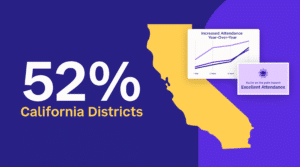
Featured Resource
Why Over Half of California School Districts Trust SchoolStatus
Read More >Join Mission: Attendance to reduce chronic absenteeism in 2025-26! >> Learn How <<






Many states have developed teacher evaluation systems with specific mandates around standards, protocols, and rubrics with the aim of ensuring that all educators improve their practice.
For transformational instructional leaders, however, these mandates can be leveraged beyond compliance; they can be a component of a bigger-picture strategy around teacher growth and development.
Read on to learn how three Oregon districts find deeper meaning in the evaluation process.
Tillamook, OR
In developing their evaluation framework, Tillamook’s goal was to create a system that “informs and enhances the practices of the educators,” says Rachel Williamson, Director of K-6 Curriculum/Title Programs. “We wanted teachers and leaders to ask ‘where are my strengths, where are my weaknesses?’, and be able identify those areas of the rubric where they’re strong and where they need to see growth.”
The district assembled a diverse evaluation committee comprising district leadership, outside experts, school leaders, and teachers, who combined state-mandated requirements with Tillamook’s own instructional initiatives.
The resulting evaluation system collects data at multiple checkpoints throughout the year, with an emphasis on teacher input.
“The self-assessment and final evaluation pieces are mirrors of one another; they collect the same information from different perspectives, which helps give a fuller picture of a teacher’s performance,” explains Williamson.
The district uses observation and self-assessment data to help inform their professional development. Williamson adds, “Principals look across their team and ask ‘Where are we, as a faculty, consistently struggling?’” By examining areas of strength and growth district-wide to plan thoughtful and relevant PD sessions, the Tillamook team uses evaluations to drive teacher development above and beyond what’s mandated at the state level.
Estacada, OR
“We are in total compliance with the evaluation standards for the state of Oregon, so that’s what you’ll see when it comes to summative evaluations,” shares Estacada High School Principal Ryan Carpenter. However, the district and the teacher’s union agree that one annual summative evaluation per teacher per year isn’t enough to get the full picture of a teacher’s performance.
Estacada has layered in an additional set of activities: Using TeachBoost, principals complete six additional classroom observations per year that focus on the district’s instructional initiatives, and which are not related to the state requirements. This gives schools more leeway to focus on their own goals and vision, and it provides school leaders a richer body of evidence to pull from when they are writing final evaluations.
“Inside TeachBoost,” says Carpenter, “I have all of this documentation from the six visits throughout the year that I can pull from and put into the final observation.”
When it comes to these informal classroom walkthroughs, the collaborative feedback process between teacher and observer is crucial. “As we identify areas of strength and weakness, or have deeper questions about an observation, it’s a smooth process,” says Carpenter. “TeachBoost notifies teachers of my questions or comments, and they can respond right there to help provide me with the data I need to inform the teacher’s future training and development.”
At a higher level, adds Carpenter, “principals review observation data on all staff members to identify areas where, as a team, we need to improve and grow, and to celebrate areas where our building is strong.” TeachBoost’s Heatmap report allows them to clearly see those trends. “We’re able to synthesize where the staff is in terms of their performance, and use that data to inform long-term planning. ”
Armed with data from the Heatmap, school and district leaders plan professional development that focuses on the specific needs they identified, providing more relevant professional learning opportunities and ultimately having a stronger impact on classroom instruction.
Grants Pass, OR
“We see evaluation as a continuous process, not something that’s contained within a given year—it’s an ongoing timeline of a teacher’s progress,” describes Dan Huber-Kantola, Director of Human Resources. “They may be on- or off-cycle by the state’s standards, but they’re always being observed and given the tools they need to grow.”
While components of the evaluation protocols at Grants Pass are state-mandated, an in-house committee designed, and continue to refine, much of the system, including the rubric, observation frequency targets, and monthly observation timelines for on-cycle and off-cycle teachers. Data drives these decisions and activities:
The main goal in this process is for teachers to improve their practice to get better student outcomes. As Huber-Kantola puts it: “We need to improve teacher practice so students are better served. Are we meeting the needs of our kids?”
The team at Grants Pass is prioritizing teacher improvement, and using their rigorous evaluation system to drive student outcomes, rather than just checking the boxes on teacher evaluation requirements.
 SchoolStatusSchoolStatus gives educators the clarity and tools they need to get students to class and keep them moving ahead. Through our integrated suite of data-driven products, we help districts spot attendance patterns early, reach families in ways that work for them, and support teacher growth with meaningful feedback. Our solutions include automated attendance interventions, multi-channel family communications in 130+ languages, educator development and coaching, streamlined digital workflows, and engaging school websites. Serving over 22 million students across thousands of districts in all 50 states, SchoolStatus helps teachers and staff see what matters, act with speed, and stay focused on students.
SchoolStatusSchoolStatus gives educators the clarity and tools they need to get students to class and keep them moving ahead. Through our integrated suite of data-driven products, we help districts spot attendance patterns early, reach families in ways that work for them, and support teacher growth with meaningful feedback. Our solutions include automated attendance interventions, multi-channel family communications in 130+ languages, educator development and coaching, streamlined digital workflows, and engaging school websites. Serving over 22 million students across thousands of districts in all 50 states, SchoolStatus helps teachers and staff see what matters, act with speed, and stay focused on students.
News, articles, and tips for meeting your district’s goals—delivered to your inbox.






